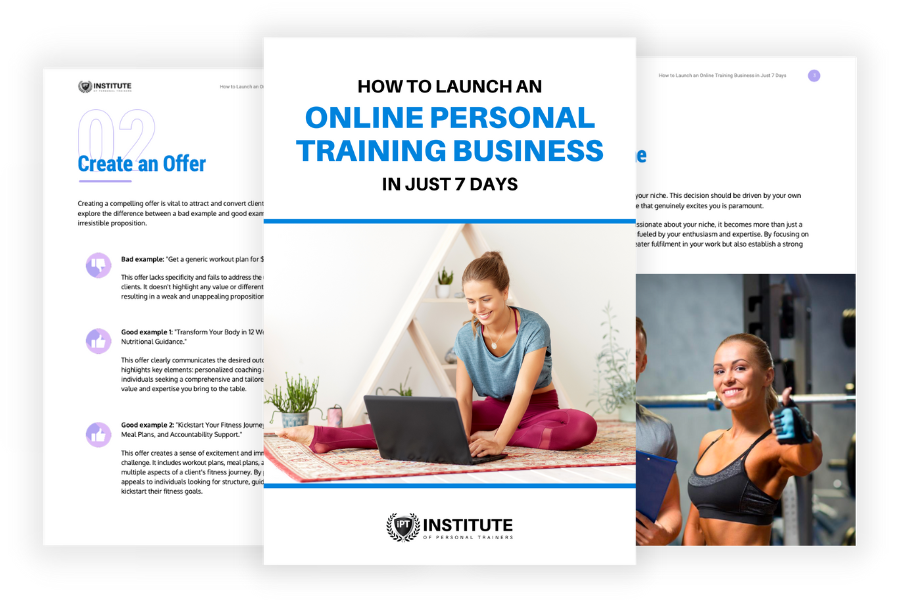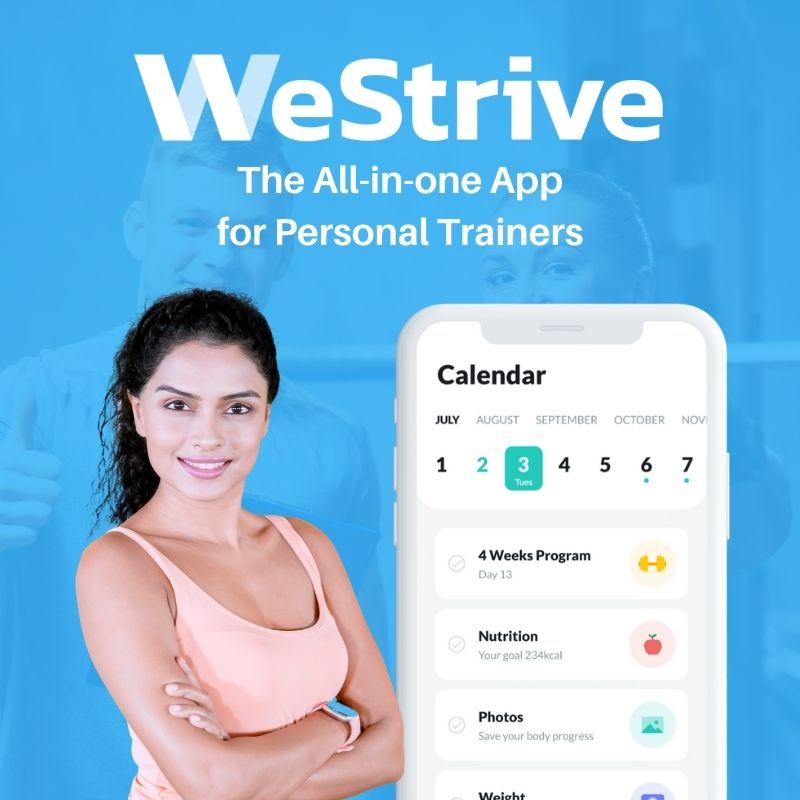|
FREE GUIDE: HOW TO LAUNCH AN ONLINE PERSONAL TRAINING BUSINESS
IN JUST 7 DAYS
✓ The new, better way of launching an online business
✓ The fastest way to create in irresistible offer ✓ A simple system to sell to clients who are interested |
|
Many people start personal training while they have the security of a regular income from another job. To begin with, personal training is a side hustle. But for many aspiring trainers, the allure of being a business owner means that they want to chase that dream. This article outlines some practical steps on how to take your personal training from a hobby, or a side hustle, into a full-time business that generates a livable income. Advantages of Becoming a Personal Trainer Full Time Having your own fitness business, and becoming a personal trainer full time means that you get to choose your own working hours. For parents of school-aged children, this level of flexibility is highly desirable. Personal training can be set up to work around the demands of your life quite easily, and you keep control over when you want to work - and when you don’t. Knowing that you have complete control over who you work with and what services you offer makes the work enjoyable. You don’t have to take on any clients that you don’t feel well suited to help, and can always refer them to someone else that’s better suited to their goals. Everyone considering this career path has likely had a significant personal experience with how fitness has improved their life. Your enthusiasm for making health a priority will be a major factor in attracting the right people to you. You can have a genuinely positive impact on someone’s life and on their health. How To Go From Part Time to Full Time You may feel ready to face your fear, and move away from that predictable income from your job and start personal training full time. The thought of doing that can be scary, and so people can sometimes keep personal training as a side hustle for longer than they need to. It’s perfectly natural to feel nervous when considering a big change that might impact your finances. The first thing is to get clear on how much money you actually need to make in order to support your lifestyle. To find it, calculate the amount of money you need to earn each month to:
And consider adding a percentage on top of this as “a buffer” in case any unexpected bills come up. For example, a new tyre after your car gets a puncture. Jonathan Goodman, of the PTDC, refers to this as your “Freedom Number” and it’s often lower than you think. Based on your freedom number, you can look at the savings in your bank account and decide if you can afford to quit your job and go full time in personal training right away, or if it would be a better idea to drop down to part-time in your job and use the time to build up your personal training client base. 8 Steps To Turn Personal Training Into A Successful Fitness Business Lots of personal trainers leave the industry because they don’t make enough money to support themselves and their families full time. However, those same trainers often won’t invest back into their businesses. It can become a vicious circle. If you want personal training to be a business, the first thing that has to happen is that you need to think of it the way a business owner would. That doesn’t mean becoming boring and corporate - clients will be attracted to your personality, so let that shine through. It means that you treat the business side of personal training seriously. This will mean different things for different trainers. We collected X tips from our members for you to consider, you may want to apply a combination of some of them or even all of them. Let's dig in. 1. Learn to Sell Not feeling weird or sleazy about taking money for personal training. You don’t have to be the cheapest personal trainer at your gym in order to pick up clients. Shying away from setting a fair price for your value means that gym patrons will see this as something you’re not serious about. Doing huge discounts to “compete” with other trainers, or training your friends for free must stop once you’re running a fitness business. It’s simply a race to the bottom. You’re no longer “looking for the experience” and you should price yourself accordingly. Selling is the Lifeblood of Any Business. Get Used to It. 2. Create Your Pricing Consider what you need to earn each month in your freedom number. Now calculate how that translates into number of clients paying Y amount per month. That can feel like an easier number to pursue than a financial target. If you have no idea how to price yourself, there are guides available. People may object to the price you ask and it’s up to you to try to overcome their objections or to walk away from that person that may need your help. In time, usually every 2 years, you’ll probably need to put your prices up as your cost of living increases. These are all normal things people expect from a business. Figure Out Your Pricing and Re-evaluate Regularly. 3. Be Professional Deliver a professional service, with proper contracts in place between you, the trainer and the client setting out your expectations. This is the time to tell them about things like a cancellation policy, or your referral scheme. It will mean turning up on time looking presentable, communicating professionally with your clients, and not spending the session checking your phone when your attention should be on them. Look, Communicate and Act as a Professional at All Times. 4. Re-invest Into Your Business Reinvest back into your business to develop your authority on a given niche. You may want to develop specialist skills that would benefit your clients, and would allow you to help them more fully. You may know what you’d like to specialise in already, or maybe that won’t be clear until you have a little more experience. But business owners reinvest into their businesses. Put Income Aside for Investments Regularly 5. Identify Your Ideal Clients This gets said a lot, and it can be a source of anxiety for many trainers. In the beginning, there’s nothing wrong with working with a broad variety of people and using this to inform what sort of clients you enjoy working with most. But you’re likely going to end up working with clients that are dealing with a problem that you have personally dealt with yourself, so that can narrow things down. Know who you want to work with. 6. Make Payments Easy Encourage clients onto a monthly payment system with you rather than paying by the hour. If you’re already on an hourly rate, this may not seem important but the lack of certainty about your finances from month to month creates stress and unpredictability in the long term. Especially if you don’t currently know when your quiet and busy periods during the year are likely to be. Offer Payment Methods That Serve Both Your Clients and Your Business 7. Don't Go Cheap It isn’t wrong to charge more than other trainers in your gym. The more money you earn, the better you can reinvest into your business and deliver an even better service for your clients. It’s not wrong to be well paid and there’s nothing virtuous about working a 12 hour day only to struggle to cover your bills. Know Your Worth and Don't Be Afraid to Ask for It 8. Enjoy Being Your Own Boss You likely got into personal training to have more personal freedom, so once you’ve decided what hours you want to work, stick to that. It’s easy to fall into the trap of working morning and night with no time left for yourself. Setting yourself working hours actually creates more freedom in the long run, so consider that early on. Don’t be afraid to say no to clients that can’t make those appointed times. You don’t need to be available all the time to make good money. Choose Your Working Hours and Stick to Them Summing Up If you’ve ever had an experience in a service industry which impressed you, consider what factors influenced that. They likely remembered your name, said hello when you came in the door and went over and above to deliver a fantastic service. They probably knew their niche incredibly well and were able to communicate with you in a way that made you feel included in the process.
The reverse is likely true for experiences that stand out as negative. The person you dealt with may have made you feel ignored or talked down to. Perhaps they didn’t use your name, or even got it wrong. Maybe you felt like their attention was elsewhere, or they turned up late, and flustered. Once you pictured both ends of the spectrum, commit to build a business you'd be happy to buy from yourself. |
Our All In One Platform
Check out out all in one business & marketing platform for personal trainers!
WEBSITE BUILDER | FUNNELS |MEMBERSHIPS | SCHEDULING| EMAIL MARKETING| PAYMENTS| CRM | AI ASSISTANT | SURVEYS
Popular Articles
Trusted Partners
We work closely with some of the best service providers in the fitness industry.
Categories
All
|







